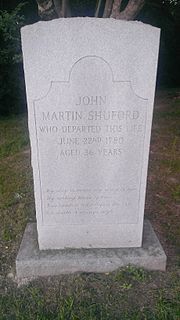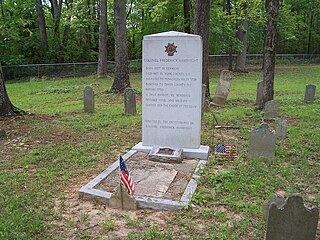Tryon County is a former county which was located in the U.S. state of North Carolina. It was formed in 1768 from the part of Mecklenburg County west of the Catawba River, although the legislative act that created it did not become effective until April 10, 1769. Due to inaccurate and delayed surveying, Tryon County encompassed a large area of northwestern South Carolina. It was named for William Tryon, governor of the North Carolina Colony from 1765 to 1771.
The Tryon Resolves were a brief declaration adopted by the citizens of Tryon County in the Province of North Carolina in the early days of the American Revolution. In the Resolves, the county vowed resistance to coercive actions by the government of Great Britain against its North American colonies. The document was signed on August 14, 1775.
The 1st North Carolina Regiment of the Continental Army was raised on September 1, 1775, at Wilmington, North Carolina. In January 1776 the organization contained eight companies. Francis Nash was appointed colonel in April 1776. The regiment was present at the defense of Charleston in 1776. It transferred from the Southern Department to George Washington's main army in February 1777. At that time, Thomas Clark became colonel of the 1st Regiment. The regiment became part of General Francis Nash's North Carolina Brigade in July.
The Battle of Cowan's Ford was a battle in the Southern Theater of Cornwallis's 1780–1782 Campaign that eventually led to the British Army's surrender at Yorktown during the American Revolutionary War. It was fought on 1 February 1781 at Cowan's ford on the Catawba River in northwestern Mecklenburg County, North Carolina, between a force of about 5,000 British and fewer than a thousand Americans who were attempting to slow the British advance across the river. The American general William Lee Davidson was killed in this battle.

The Battle of Ramsour's Mill took place on June 20, 1780 in present-day Lincolnton, North Carolina, during the British campaign to gain control of the southern colonies in the American Revolutionary War. The number of fighters on each side of the battle is still an issue of contention, but Loyalist militiamen outnumbered Patriot militia and had captured a group of Patriots who they were planning to hang on the morning of June 20.

Frederick Hambright was a military officer who fought in both the local militia and in the North Carolina Line of the Continental Army during the Revolutionary War. He is best known for his participation in the Battle of Kings Mountain in 1780. Serving as a statesman early in the Revolution, Hambright joined the War in 1777, ranked a lieutenant colonel in a local militia. His early actions were limited to occasional checks on Loyalist groups. This changed in 1780 with Hambright's important role at the Battle of Kings Mountain, which occurred near his lands in the newly formed Lincoln County, North Carolina. Hambright was commended for his bravery during the battle, though suffering a wound which forced him to permanently resign from military service.
Joseph Hardin Sr. was an Assemblyman for the Province of North Carolina, and was a signatory of the Tryon Resolves. Early in the War for Independence, as a member of the militia from Tryon County, Hardin fought the Cherokee allies of Britain along the western frontier. Later in the war, having taken his family over the Appalachian Mountains to the Washington District for safety against the advance of the Red Coats out of South Carolina, Hardin joined the Overmountain Men. He saw action at the Battle of Ramsour's Mill and the decisive Battle of Kings Mountain. Following the peace with Britain, Hardin was a co-founder and second Speaker of the House for the State of Franklin; and an Assemblyman in the Southwest Territory before its statehood as Tennessee.
Colonel William Graham was commander of the Tryon County and Lincoln County Regiments of the North Carolina militia and political leader from North Carolina during the American Revolution.
James Johnston was an officer in the Tryon County Regiment and Lincoln County Regiments of the North Carolina militia in the American Revolution, a delegate to the North Carolina Provincial Congress in 1776, and a state senator in 1780–1782.
The Salisbury District of North Carolina, was originally one of six colonial judicial districts established in 1766 by the Governor William Tryon of the Province of North Carolina. Immediately preceding the onset of the American War of Independence in 1775, these six regions were renamed "Military districts" by the North Carolina Provincial Congress and used for organizing the North Carolina militia. The other districts were Edenton, Halifax, Hillsborough, New Bern, and Wilmington districts. The districts designation was discontinued in 1835 during the North Carolina Constitution Convention.
The Salisbury District Brigade was an administrative division of the North Carolina militia during the American Revolutionary War (1776–1783). This unit was established by the Fourth North Carolina Provincial Congress on May 4, 1776, and disbanded at the end of the war.
The Rowan County Regiment was originally established in about August 1, 1775 as a local militia in Rowan County in the Province of North-Carolina. When the North Carolina Provincial Congress authorized thirty-five existing county militias to be organized on September 9, 1775, the Rowan County Regiment was included and all officers were appointed with commissions from the Provincial Congress. The members of the Rowan County Regiment were mostly from what was Rowan County at the time. Prior to establishment of the Rowan County Regiment, many of its officers were active in the Rowan County Committee of Safety. The regiment included 160 known companies and one or more of these companies were engaged in 36 known battles or skirmishes during the American Revolution. After the establishment of the Rowan County Regiment, several other counties were created from Rowan County, including Burke County in 1777, Iredell County in 1788, Davidson County in 1822 and Davie County in 1836.
The 2nd Rowan County Regiment was first established in October 22, 1775 as a local militia in Rowan County in the Province of North-Carolina. This regiment was created from the existing Rowan County Regiment of militia. Its original officers were Col Adlai Osborne, Lt Col Christopher Beekman, and Major Charles McDowell. Adlai Osborne was a leader in Rowan County and member of the Rowan County Committee of Safety. On May 9, 1777, the regiment was renamed the Burke County Regiment, which was active until the end of the Revolutionary War in 1783.
The Montgomery County Regiment was authorized on February 8, 1778 by the North Carolina General Assembly of 1778. It was created at the same time that Montgomery County, North Carolina was created out of the northern half of Anson County, North Carolina. It was subordinate to the Salisbury District Brigade of militia. The regiment was engaged in battles and skirmishes against the British and Cherokee during the American Revolution in North Carolina, South Carolina and Georgia between 1776 and 1781. It was active until the end of the war.
The Surry County Regiment was established on August 26, 1775 by the North Carolina Provincial Congress. The regiment was engaged in battles and skirmishes against the British and Cherokee during the American Revolution in North Carolina, South Carolina Tennessee, and Georgia between 1776 and 1782. It was active until the end of the war.
The Rutherford County Regiment was authorized on October 30, 1779, by the Province of North Carolina Congress. It was created at the same time that Rutherford County, North Carolina was created out of the western part of Tryon County, North Carolina when Tryon County and its regiment of militia were abolished. Officers were appointed and commissioned by the Governor. The regiment was engaged in battles and skirmishes against the British during the American Revolution in North Carolina, Georgia, and South Carolina between 1779 and 1782. It was active until the end of the war.
The Wilkes County Regiment was authorized on December 9, 1777 by the Province of North Carolina Congress at the same time that Wilkes County, North Carolina was created from Surry County, North Carolina and Washington District, North Carolina. The regiment was subordinate to the Salisbury District Brigade of militia. It was engaged in battles and skirmishes against the British and Cherokee during the American Revolution in North Carolina, South Carolina, Tennessee, and Georgia between 1779 and 1782. It was active until the end of the war.
The Mecklenburg County Regiment was authorized on May 31, 1775 by the Province of North Carolina Congress. From November 7, 1779 until the 3rd Quarter of 1780, it was called the 1st Mecklenburg County Regiment when a 2nd Mecklenburg County Regiment existed. The 1st Mecklenburg County regiment was engaged in 39 known battles and skirmishes against the British during the American Revolution in North Carolina, South Carolina and Georgia between 1776 and 1781. It was active until the end of the war.
North Carolina state troops in the American Revolution were the initial military units created in a transition from the Province of North Carolina under British rule to independence from British rule. Most units did not last long as such and were either transferred to the Continental Army or state militia instead.
The Carteret County Regiment was authorized by the North Carolina Provincial Congress on September 9, 1775. It was subordinate to the New Bern District Brigade after May 4, 1776. The regiment was engaged in battles or skirmishes against the British during the American Revolution, including the Battle of Stono Ferry and the Battle of Beaufort. The regiment also existed during the colonial period in the Province of North Carolina.

